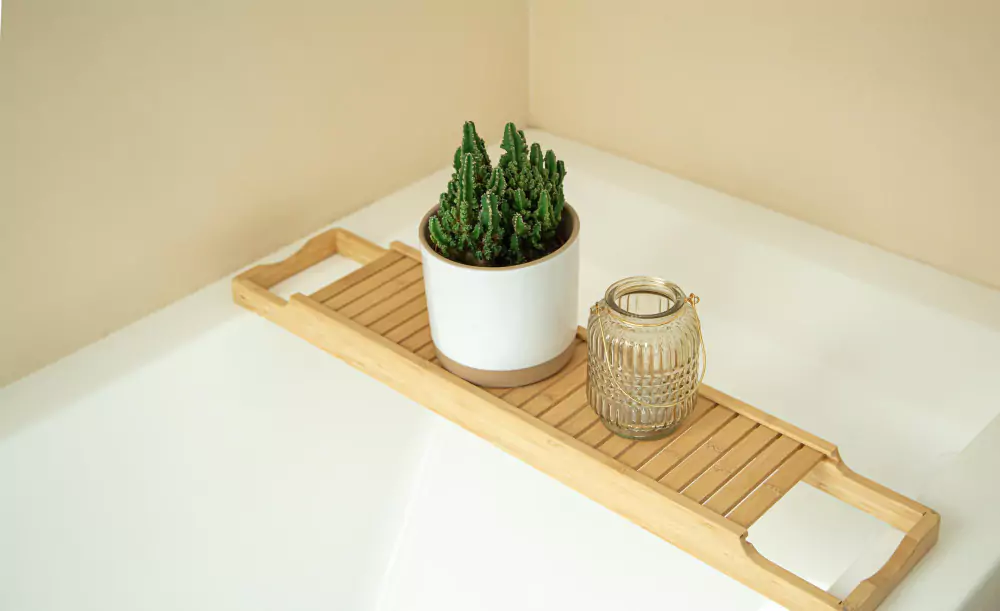Want to create a fresh, new bathroom look that’s relaxing, clean, and chic? If you’re in Toronto and fantasizing about a bathroom that has the warmth of Scandinavian style blended with the sophistication of Japanese simplicity, then Japandi bathroom inspiration is all you need. Such a popular style is ideal for city residences—especially when you need a calming oasis after a hectic day.
In this post, we’ll demonstrate how Japandi style is perfect for Toronto homes. No matter if you have a downtown condo apartment or a GTA family home, you’ll see intelligent, stunning ideas that fit your home. From organic materials to muted hues and intelligent floor plans, you’ll learn how to bring this eclectic look into your bathroom—along with gain practical renovation advice along the way.
Table of Contents
Japandi Bathroom Ideas in Toronto Homes
Japandi style is rapidly becoming one of the most popular options for Toronto residents looking for a serene, uncluttered bathroom. It combines the minimalist aesthetic of Japanese interiors with the coziness and practicality of Scandinavian design. The end result is a natural, clean, and serene space—ideal for urban life.
In Toronto, where the majority of homes and condos have smaller bathrooms, Japandi is particularly effective. Its efficient use of space, pale color palette, and sparse decor ensure even tiny rooms feel airy and rejuvenating. Imagine smooth wood tones, pale neutral shades, floating vanities, and natural light. They produce a spa-like ambiance that de-stresses you after a long day.
Japandi bathrooms also complement Toronto’s emphasis on modern living and sustainability. Employing green materials such as bamboo, oak, or stone and selecting long-lasting high-quality fixtures also promotes a greener lifestyle. It is convenient to acquire these natural finishes in the GTA, as local suppliers are readily available, allowing you to have style and sustainability in a single renovation.
Whether you’re remodeling the entire house or simply making a few impactful changes, Japandi bathroom inspiration provides an enduring look that perfectly blends with today’s homes in Toronto.

What Is Japandi Bathroom Style?
Japandi bathroom style is a designing approach that blends two strong styles—Japanese simplicity and Scandinavian coziness. It integrates clean lines, natural texture, and a soothing colour palette to form bathrooms that are modern, serene, and practical.
At its core, Japandi design focuses on simplicity and purpose. You’ll often see clutter-free spaces, soft neutral tones like beige, grey, or warm white, and natural materials such as wood, stone, or bamboo. Every element in a Japandi bathroom has a clear role—whether it’s a floating vanity that saves space, open shelving for easy access, or a deep soaking tub for relaxation.
This aesthetic also prioritizes harmony with nature, making it an excellent choice for environmentally aware Toronto homeowners. Selecting eco-friendly materials, energy-efficient lighting, and low-flow fixtures benefits the planet and your way of life. The balance between form and function is what makes Japandi bathroom inspiration so ideal for today’s renovations.
If you desire a bathroom that provides a soothing refuge—without sacrificing style or functionality—Japandi could be the ideal design path for your dwelling.
Top 5 Japandi Bathroom Design Elements
If you’re interested in introducing Japandi bathroom inspiration into your Toronto dwelling, it’s beneficial to know the main design elements that characterize the style. Every aspect is centered on simplicity, functionality, and natural beauty–perfect for small or larger bathrooms throughout the GTA.
1. Natural Materials
Japandi bathrooms are also famous for applying natural materials such as light wood, stone, and bamboo. They add warmth and texture to the area without making the whole appearance busy and dirty. In Toronto, you can easily shop for quality oak or walnut vanities, slate or stone tiles, and bamboo accessories from local vendors.
2. Soft, Neutral Colour Palette
The Japandi bathroom colour scheme gravitates to soft, natural hues. Consider beige, cream, pale grey, and muted green. These soothing colours achieve a serene spa-like ambiance, ideal for busy Toronto city living.
3. Simple Fixtures
Japandi design values function over decoration. This means using minimalist fixtures like wall-mounted faucets, floating vanities, and simple lighting. These pieces don’t just save space—they also give your bathroom a sleek, modern look.
4. Thoughtful Storage
Uncluttered areas are a fundamental element of Japandi design. Employ open shelving, concealed cabinetry, or built-in storage to create a tidy and organized bathroom. In petite Toronto bathrooms, intelligent storage is particularly crucial for creating a minimalist ambiance.
5. Natural Light and Greenery
To finish the Japandi atmosphere, emphasize light and nature. Big mirrors, cozy LED light, and some green plants can make the area seem bright and refreshing. Even a small potted plant or a greenery-filled hanging shelf can provide a natural feel that bridges your bathroom to the outside world.

Toronto Renovation Process: Step-by-Step Guide
Planning a Japandi bathroom remodel in Toronto? No matter if you’re a condo downtown or a suburban family home, an organized renovation process can make the process stress-free and successful. Here’s a step-by-step guide to help you transform your Japandi bathroom inspiration into a reality.
1. Define Your Vision and Budget
Begin by gathering ideas for designs and budgeting how much you’d like to spend. Research Japandi design elements such as natural wood vanities, floating shelves, and minimalist lighting. Create a budget with materials, labour, and extra costs included.
2. Get Advice from a Local Bathroom Renovation Specialist
Work with a trusted Toronto contractor—like BathGuys—who understands Japandi design principles. An experienced renovation team will help you choose the right materials, create a layout that suits your space, and ensure quality workmanship.
3. Design and Material Selection
Choose materials that embody the Japandi style: pale woods (e.g., oak or ash), stone plank tiles, and matte black or brushed metal hardware. Opt for a muted, pale colour scheme to create a serene ambiance. If eco-friendliness is your concern, opt for locally sourced, sustainable materials in the GTA.
4. Get Permits (If Necessary)
Based on how much you’re remodeling, you might require permits—particularly for plumbing or structural work. Your licensed contractor will take you through this process and ensure all the work adheres to Toronto building regulations.
5. Demolition and Preparation
The group starts by demolishing the existing fixtures, tiles, and fittings after planning and permits are acquired. Site preparation in a proper manner ensures there’s a clean slate for the new elements of Japandi design to be fitted in.
6. Installation and Construction
This stage involves the addition of new flooring, vanities, lighting, and other fixtures. Clean lines and impeccable finishes are essential—Japandi design means attention to detail is paramount. Waterproofing and ventilation are also essential in order to safeguard your investment, particularly in damp bathrooms.
7. Final Touches and Clean-Up
Once the main work is done, finishing touches make the room come alive. Include soft lighting, wooden accents, and a touch of greenery to finish off the Japandi style. A proper clean-up gets your new bathroom ready to be used.
8. Inspection and Walkthrough
A professional renovation firm will conduct a final walk-through with you to verify that each aspect meets your requirements. You’ll also get care instructions for keeping your Japandi bathroom in pristine condition.
Real-Life BathGuys Japandi Projects (Toronto)
At BathGuys, we’ve assisted numerous Toronto residents in realizing their Japandi bathroom vision—turning aging or small bathrooms into contemporary, serene areas that embody authentic Japandi design.
Project 1: Small Condo Bathroom, Downtown Toronto
In a small condo unit off Queen Street West, our designers produced a Japandi-style retreat with light oak floating vanities, grey stone tiles, and warm ambient lighting. The small space was optimized through the use of wall-mounted elements and secret storage, keeping the space tidy and streamlined. The outcome was a warm, spa-like bathroom that optimally used every square inch.
Project 2: Family Home Renovation, North York
For a growing family in North York, we redesigned the master ensuite using eco-friendly materials and soft natural finishes. We installed a deep soaking tub, matte black fixtures, and warm wooden cabinetry. With plenty of natural light and minimalist design, the space now feels like a relaxing escape from the busy city life—true to Japandi’s calming essence.
Project 3: Full Remodel in Etobicoke
This project was a full makeover of a 90s bathroom into a peaceful Japandi oasis. The homeowners desired a clean, contemporary look with eco-friendly materials. We incorporated bamboo shelving, stone floors, and muted paint colors. We also included plants and dim lighting for a harmonious, calm ambiance. The homeowners loved the harmony of style and minimalism.
Why These Projects Matter
These real-world examples illustrate how Japandi design can be applied to all sorts of Toronto residences— compact downtown apartments as well as wider suburban homes. More significantly, they demonstrate BathGuys’ experience, work ethic, and dedication to providing both form and function in each renovation.

Also Read this: Best Bathroom Flooring Options for Canadian Homes
Common Challenges & How to Overcome Them
While it is rewarding to revamp your area with Japandi bathroom ideas, Toronto homeowners can expect to encounter several typical challenges in the process of renovation. Knowing these problems—and how to overcome them—can save you time, stress, and money.
1. Limited Space in Toronto Homes
Challenge: Toronto condos and older houses have tiny bathrooms that restrict the application of Japandi’s open and spacious look.
Solution: Emphasize clever design decisions such as floating vanities, wall-mounted lighting, and pale colors to make a space feel more expansive. Open shelving and recessed storage keep the look clean and uncluttered without diminishing functionality.
2. Getting Materials Right
Challenge: Japandi style depends upon natural and frequently sustainable materials such as oak, bamboo, and stone—occasionally not easily available locally.
Solution: Collaborate with seasoned renovation firms such as BathGuys who have established relationships with reliable suppliers throughout the GTA. They can suggest top-quality, eco-friendly materials that fit both your budget and vision.
3. Balancing Warmth and Minimalism
Challenge: It’s simple to make the area feel too bland or chilly when it comes to creating a minimalist aesthetic.
Solution: Balance simplicity with warmth through layering textures—wood tones, soft textiles, and greenery. Personality is added by subtle touches such as matte black hardware or warm LED lighting without clutter.
4. Budget Limitations
Challenge: Quality materials and expert labor tend to drive your renovation expenses over the anticipated budget.
Solution: Give priority to principal Japandi elements that create maximum visual and functional impact, such as a floating vanity or natural stone tiles. Fix a practical budget and hire a professional who can walk you through cost-saving options that will still produce the effect.
5. Building Code and Permit Delays
Challenge: Toronto’s building codes and permitting process have the potential to delay renovations, particularly if structural or plumbing work is involved.
Solution: Engage a locally licensed contractor familiar with Toronto code. They will get all the paperwork and inspections out of the way quickly, keeping your project on schedule.
Conclusion
Developing a peaceful and chic bathroom based on Japandi bathroom ideas in Toronto is not merely a trend—it’s a lifestyle revolution. This soothing combination of Scandinavian simplicity and Japanese sophistication adds warmth, functionality, and ease to your daily life. Whether you’re dealing with a compact condo dwelling or a sprawling family residence, Japandi style seamlessly scales. With seasoned local assistance from BathGuys, your ideal bathroom becomes a reality—designed with care, environmentally friendly materials, and enduring value. For considered, contemporary bathroom remodels in the GTA, select BathGuys as your renovation expert.
What is a Japandi bathroom style?
A Japandi bathroom combines Japanese and Scandinavian design elements, focusing on simplicity, functionality, and natural materials. It features clean lines, warm tones, and clutter-free spaces to promote relaxation and harmony.
Is Japandi bathroom design suitable for small Toronto homes?
Yes, Japandi design works well in small spaces often found in Toronto condos and older homes. Its minimalist approach and smart storage solutions help maximize space while maintaining a clean and open feel.
How much does a Japandi bathroom renovation cost in Toronto?
On average, a Japandi bathroom renovation in Toronto can cost between $14,000 and $30,000. The final price depends on factors like materials, bathroom size, design complexity, and labour.
Can BathGuys help with Japandi-style bathroom renovations?
Absolutely. BathGuys specializes in custom Japandi bathroom renovations in Toronto and the GTA. Our team offers expert design guidance, quality craftsmanship, and local renovation experience to bring your vision to life.
What materials are commonly used in Japandi bathrooms?
Japandi bathrooms often use natural materials like wood (bamboo or oak), stone tiles, matte black fixtures, and neutral paint tones. These choices create a calm, organic, and balanced look while promoting durability.





